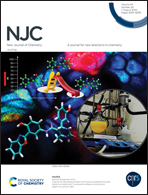Understanding the reactivity of carbene-analogous phosphane complexes with group 13 elements as a central atom: a theoretical investigation†
Abstract
The reactions of carbenic cations (PtBu3)2M+ (M = B, Al, Ga, In, and Tl) with methane and ethene are studied using density functional theory. The activation energies and reaction enthalpies are analyzed by the energy decomposition analysis (EDA) to understand the reactivity of the reactions. For the reactions with methane, the activation energies and reaction enthalpies increase with the atomic numbers of the group 13 elements (M). For the reactions with ethene, the activation energies and reaction enthalpies also increase with the atomic numbers of M but with a notable exception. The activation energy of the reaction of (PtBu3)2B+ with ethene is abnormally higher than those of (PtBu3)2Al+ and (PtBu3)2Ga+. The activation energy abnormality is due to the excessive strain energy associated with the tremendous structural deformation, in which (PtBu3)2B+ has to reform in order to reach the prepared conformation of the transition state. The present theoretical evidence reveals that the atomic radius of the central group 13 element M of the carbenic (PtBu3)2M+ species plays a key role in both insertion and [1+2] cycloaddition reactions. In other words, this can be traced back to the fundamental reason that the 2s and 2p orbitals are more amenable to hybridize than the other ns and np orbitals for n ≥ 3.



 Please wait while we load your content...
Please wait while we load your content...